2007 CHEVROLET EQUINOX instrument panel
[x] Cancel search: instrument panelPage 152 of 492

Turn and Lane-Change Signals
The turn signal has two upward (for right) and
two downward (for left) positions. These positions
allow you to signal a turn or a lane change.
To signal a turn, move the lever all the way up or
down. When the turn is �nished, the lever will
return automatically.
An arrow on the
instrument panel
cluster will �ash in
the direction of the
turn or lane change.
To signal a lane change, raise or lower the lever
until the arrow starts to �ash. Hold it there until you
complete the lane change. The lever will return
by itself when you release it.As you signal a turn or a lane change, if the
arrows �ash rapidly, a signal bulb may be burned
out and other drivers won’t see your turn signal.
If a bulb is burned out, replace it to help avoid an
accident. If the arrows do not go on at all when you
signal a turn, check the fuse, seeFuses and Circuit
Breakers on page 429and for burned-out bulbs.
Headlamp High/Low-Beam Changer
To change the headlamps from low beam to
high, push the turn signal lever away from you.
To change from high beam to low beam, pull the
turn signal lever towards you. To �ash the
high beams from low beam, pull the turn signal
lever all the way towards you. Then release it.
When the high beams
are on, this light on
the instrument panel
cluster will also be on.
152
Page 155 of 492
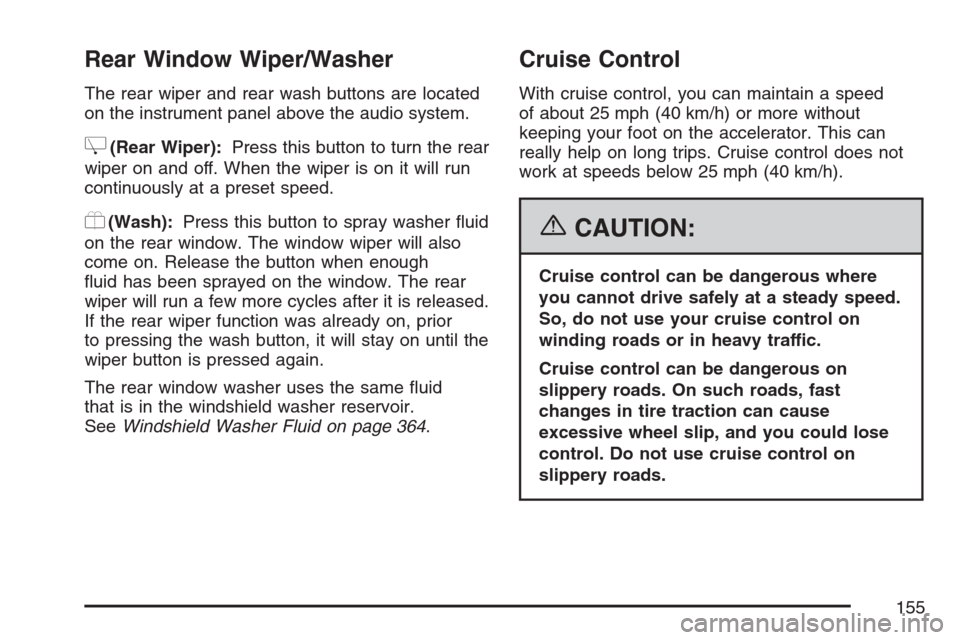
Rear Window Wiper/Washer
The rear wiper and rear wash buttons are located
on the instrument panel above the audio system.
Z(Rear Wiper):Press this button to turn the rear
wiper on and off. When the wiper is on it will run
continuously at a preset speed.
Y(Wash):Press this button to spray washer �uid
on the rear window. The window wiper will also
come on. Release the button when enough
�uid has been sprayed on the window. The rear
wiper will run a few more cycles after it is released.
If the rear wiper function was already on, prior
to pressing the wash button, it will stay on until the
wiper button is pressed again.
The rear window washer uses the same �uid
that is in the windshield washer reservoir.
SeeWindshield Washer Fluid on page 364.
Cruise Control
With cruise control, you can maintain a speed
of about 25 mph (40 km/h) or more without
keeping your foot on the accelerator. This can
really help on long trips. Cruise control does not
work at speeds below 25 mph (40 km/h).
{CAUTION:
Cruise control can be dangerous where
you cannot drive safely at a steady speed.
So, do not use your cruise control on
winding roads or in heavy traffic.
Cruise control can be dangerous on
slippery roads. On such roads, fast
changes in tire traction can cause
excessive wheel slip, and you could lose
control. Do not use cruise control on
slippery roads.
155
Page 156 of 492

Setting Cruise Control
{CAUTION:
If you leave your cruise control on when
you are not using cruise, you might hit a
button and go into cruise when you do not
want to. You could be startled and even
lose control. Keep the cruise control switch
off until you want to use cruise control.
The cruise control
buttons are located
on the left side of
the steering wheel.
J(On/Off):Press this button to turn the cruise
control system on and off. The indicator light is on
when cruise control is on and turns off when
cruise control is off.
+RES (Resume):Press this button to resume a
set speed and to accelerate the speed.
SET−(Set):Press this button to set a speed and
to decrease the speed.
[(Cancel):Press this button to cancel cruise
control without erasing the set speed from memory.
Setting Cruise Control
The cruise control light on the instrument panel
cluster will come on after the cruise control
has been set to the desired speed.
1. Press the on/off button to turn cruise control on.
2. Get up to the speed you want.
3. Press the SET−button and release it.
4. Take your foot off the accelerator pedal.
When the brakes are applied, the cruise control
shuts off.
156
Page 157 of 492
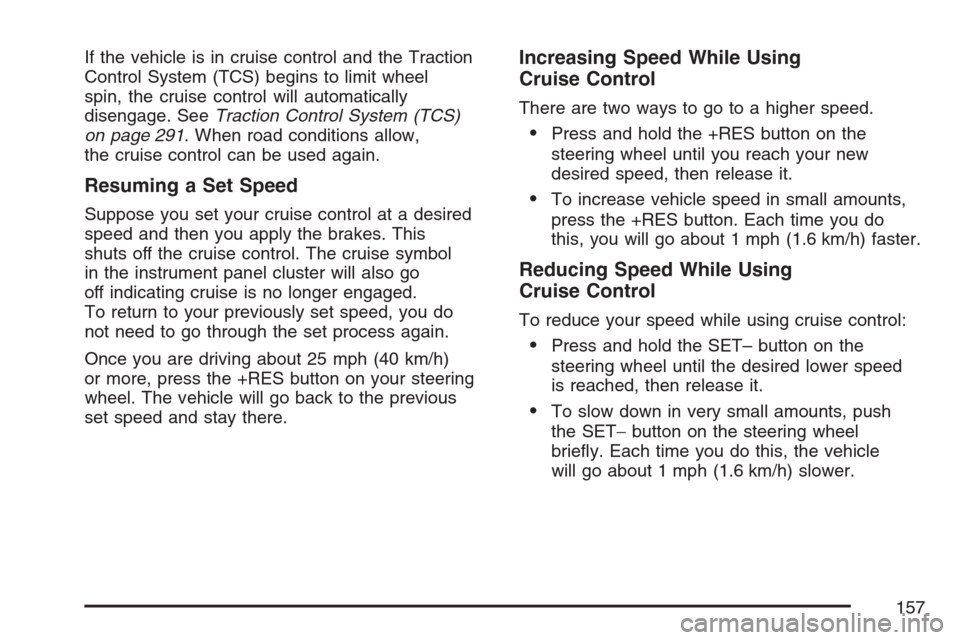
If the vehicle is in cruise control and the Traction
Control System (TCS) begins to limit wheel
spin, the cruise control will automatically
disengage. SeeTraction Control System (TCS)
on page 291. When road conditions allow,
the cruise control can be used again.
Resuming a Set Speed
Suppose you set your cruise control at a desired
speed and then you apply the brakes. This
shuts off the cruise control. The cruise symbol
in the instrument panel cluster will also go
off indicating cruise is no longer engaged.
To return to your previously set speed, you do
not need to go through the set process again.
Once you are driving about 25 mph (40 km/h)
or more, press the +RES button on your steering
wheel. The vehicle will go back to the previous
set speed and stay there.
Increasing Speed While Using
Cruise Control
There are two ways to go to a higher speed.
Press and hold the +RES button on the
steering wheel until you reach your new
desired speed, then release it.
To increase vehicle speed in small amounts,
press the +RES button. Each time you do
this, you will go about 1 mph (1.6 km/h) faster.
Reducing Speed While Using
Cruise Control
To reduce your speed while using cruise control:
Press and hold the SET– button on the
steering wheel until the desired lower speed
is reached, then release it.
To slow down in very small amounts, push
the SET−button on the steering wheel
brie�y. Each time you do this, the vehicle
will go about 1 mph (1.6 km/h) slower.
157
Page 159 of 492
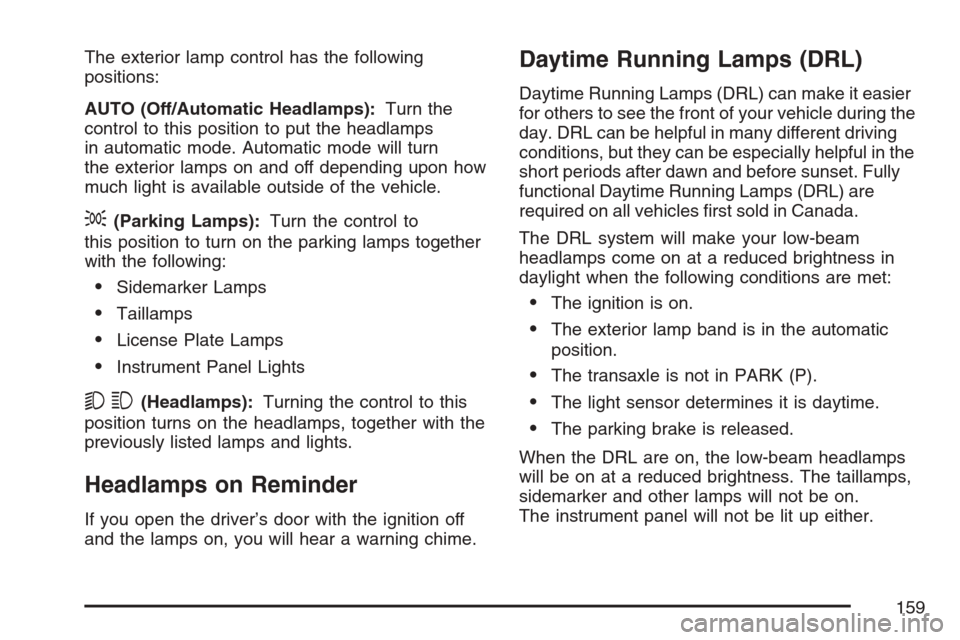
The exterior lamp control has the following
positions:
AUTO (Off/Automatic Headlamps):Turn the
control to this position to put the headlamps
in automatic mode. Automatic mode will turn
the exterior lamps on and off depending upon how
much light is available outside of the vehicle.
;(Parking Lamps):Turn the control to
this position to turn on the parking lamps together
with the following:
Sidemarker Lamps
Taillamps
License Plate Lamps
Instrument Panel Lights
53(Headlamps):Turning the control to this
position turns on the headlamps, together with the
previously listed lamps and lights.
Headlamps on Reminder
If you open the driver’s door with the ignition off
and the lamps on, you will hear a warning chime.
Daytime Running Lamps (DRL)
Daytime Running Lamps (DRL) can make it easier
for others to see the front of your vehicle during the
day. DRL can be helpful in many different driving
conditions, but they can be especially helpful in the
short periods after dawn and before sunset. Fully
functional Daytime Running Lamps (DRL) are
required on all vehicles �rst sold in Canada.
The DRL system will make your low-beam
headlamps come on at a reduced brightness in
daylight when the following conditions are met:
The ignition is on.
The exterior lamp band is in the automatic
position.
The transaxle is not in PARK (P).
The light sensor determines it is daytime.
The parking brake is released.
When the DRL are on, the low-beam headlamps
will be on at a reduced brightness. The taillamps,
sidemarker and other lamps will not be on.
The instrument panel will not be lit up either.
159
Page 160 of 492
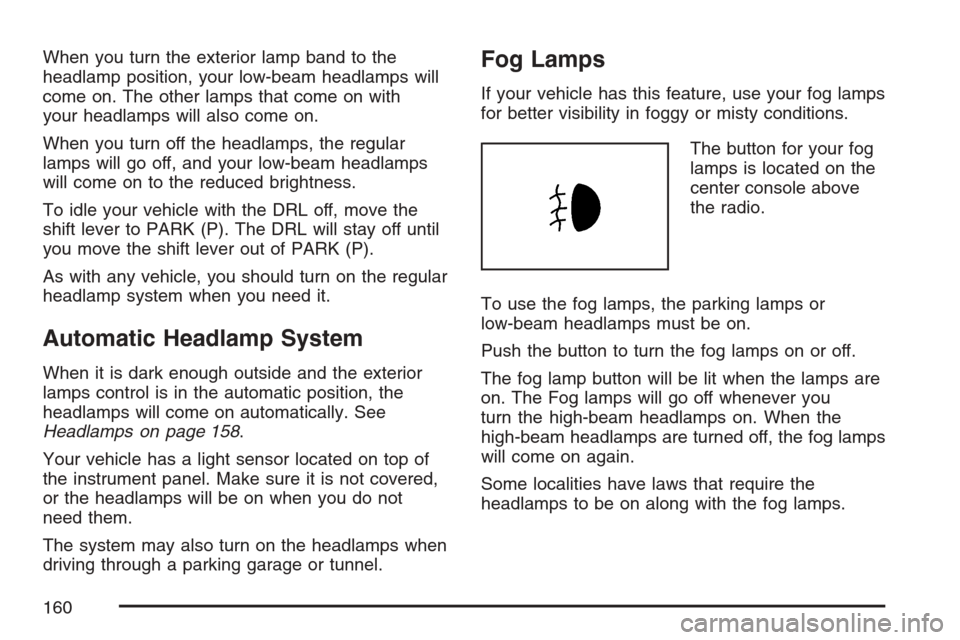
When you turn the exterior lamp band to the
headlamp position, your low-beam headlamps will
come on. The other lamps that come on with
your headlamps will also come on.
When you turn off the headlamps, the regular
lamps will go off, and your low-beam headlamps
will come on to the reduced brightness.
To idle your vehicle with the DRL off, move the
shift lever to PARK (P). The DRL will stay off until
you move the shift lever out of PARK (P).
As with any vehicle, you should turn on the regular
headlamp system when you need it.
Automatic Headlamp System
When it is dark enough outside and the exterior
lamps control is in the automatic position, the
headlamps will come on automatically. See
Headlamps on page 158.
Your vehicle has a light sensor located on top of
the instrument panel. Make sure it is not covered,
or the headlamps will be on when you do not
need them.
The system may also turn on the headlamps when
driving through a parking garage or tunnel.
Fog Lamps
If your vehicle has this feature, use your fog lamps
for better visibility in foggy or misty conditions.
The button for your fog
lamps is located on the
center console above
the radio.
To use the fog lamps, the parking lamps or
low-beam headlamps must be on.
Push the button to turn the fog lamps on or off.
The fog lamp button will be lit when the lamps are
on. The Fog lamps will go off whenever you
turn the high-beam headlamps on. When the
high-beam headlamps are turned off, the fog lamps
will come on again.
Some localities have laws that require the
headlamps to be on along with the fog lamps.
160
Page 161 of 492
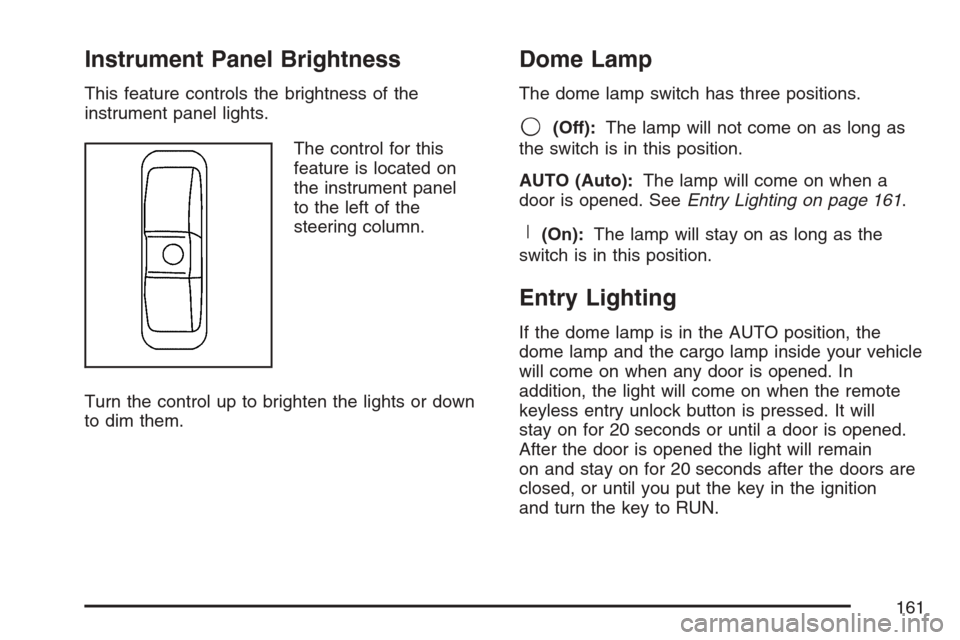
Instrument Panel Brightness
This feature controls the brightness of the
instrument panel lights.
The control for this
feature is located on
the instrument panel
to the left of the
steering column.
Turn the control up to brighten the lights or down
to dim them.
Dome Lamp
The dome lamp switch has three positions.
9(Off):The lamp will not come on as long as
the switch is in this position.
AUTO (Auto):The lamp will come on when a
door is opened. SeeEntry Lighting on page 161.
R(On):The lamp will stay on as long as the
switch is in this position.
Entry Lighting
If the dome lamp is in the AUTO position, the
dome lamp and the cargo lamp inside your vehicle
will come on when any door is opened. In
addition, the light will come on when the remote
keyless entry unlock button is pressed. It will
stay on for 20 seconds or until a door is opened.
After the door is opened the light will remain
on and stay on for 20 seconds after the doors are
closed, or until you put the key in the ignition
and turn the key to RUN.
161
Page 166 of 492
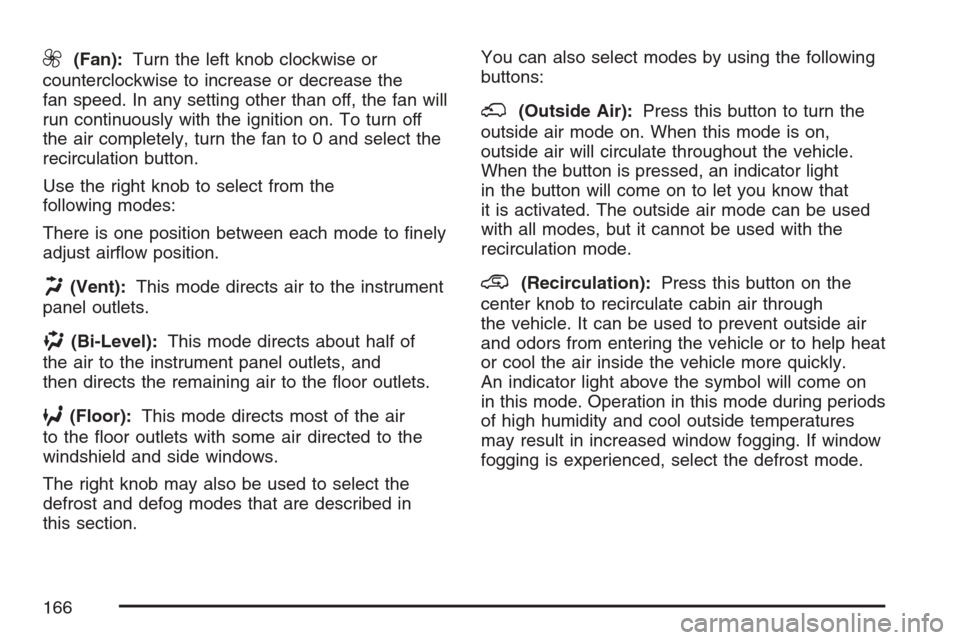
9(Fan):Turn the left knob clockwise or
counterclockwise to increase or decrease the
fan speed. In any setting other than off, the fan will
run continuously with the ignition on. To turn off
the air completely, turn the fan to 0 and select the
recirculation button.
Use the right knob to select from the
following modes:
There is one position between each mode to �nely
adjust air�ow position.
H(Vent):This mode directs air to the instrument
panel outlets.
)(Bi-Level):This mode directs about half of
the air to the instrument panel outlets, and
then directs the remaining air to the �oor outlets.
6(Floor):This mode directs most of the air
to the �oor outlets with some air directed to the
windshield and side windows.
The right knob may also be used to select the
defrost and defog modes that are described in
this section.You can also select modes by using the following
buttons:
;(Outside Air):Press this button to turn the
outside air mode on. When this mode is on,
outside air will circulate throughout the vehicle.
When the button is pressed, an indicator light
in the button will come on to let you know that
it is activated. The outside air mode can be used
with all modes, but it cannot be used with the
recirculation mode.
@(Recirculation):Press this button on the
center knob to recirculate cabin air through
the vehicle. It can be used to prevent outside air
and odors from entering the vehicle or to help heat
or cool the air inside the vehicle more quickly.
An indicator light above the symbol will come on
in this mode. Operation in this mode during periods
of high humidity and cool outside temperatures
may result in increased window fogging. If window
fogging is experienced, select the defrost mode.
166